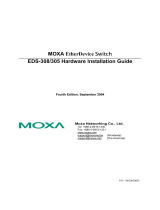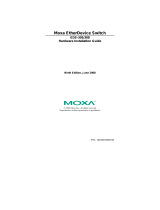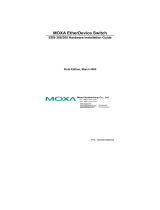Page is loading ...

P/N: 1802002100012
*1802002100012*
EDS-210A
Quick Installation Guide
Moxa EtherDevice Switch
Edition 3.0, February 2017
Technical Support Contact Information
www.moxa.com/support
Moxa Americas:
Toll
-free: 1-888-669-2872
Tel:
1-714-528-6777
Fax:
1-714-528-6778
Moxa China (Shanghai office):
Toll
-free: 800-820-5036
Tel:
+86-21-5258-9955
Fax:
+86-21-5258-5505
Moxa Europe:
Tel:
+49-89-3 70 03 99-0
Fax:
+49-89-3 70 03 99-99
Moxa Asia-Pacific:
Tel:
+886-2-8919-1230
Fax:
+886-2-8919-1231
Moxa India:
Tel:
+91-80-4172-9088
Fax:
+91-80-4132-1045
2017 Moxa Inc. All rights reserved.

- 2 -
Overview
EDS-210A series 10-port industrial Ethernet switches are equipped with 1
Gigabit fiber optic Ethernet port, up to 8 10/100M copper ports, and 4
100M fiber optic Ethernet ports, making it ideal for applications that
require high bandwidth data convergence and long-distance uplinks. The
EDS-210A series provides 12/24/48 VDC redundant power inputs, has a
rugged IP30-rated metal housing, and is DIN-rail mountable. These
switches are compliant with FCC/UL/CE standards and undergo a 100%
burn-in test to ensure that they fulfill the special needs of industrial
automation control applications. The EDS-210A series has a -10 to 60°C
operating temperature range and is also available with wide-temperature
operation (-40 to 75°C).
NOTE
Throughout this Hardware Installation Guide, we use EDS
as an
abbreviation for Moxa EtherDevice Switch:
EDS = Moxa EtherDevice Switch
Package Checklist
Your EDS is shipped with the following items. If any of these items is
missing or damaged, please contact your customer service
representative for assistance.
• Moxa EtherDevice™ Switch
• Protective caps for unused ports
• Quick installation guide (printed)
• Warranty card
Features
High Performance Network Switching Technology
• 10/100/1000BaseT(X) (EDS-210A-1GTX-1GSFP-4SFP only),
10/100BaseT(X) auto-negotiation speed, full/half duplex mode, auto
MDI/MDI-X connection, and 100Base SFP slot /1000Base SFP slot.
• IEEE 802.3 for 10BaseT, IEEE 802.3u for 100BaseT(X), IEEE 802.3ab
for 1000BaseT, and IEEE 802.3z for 1000BaseX.
• Store-and-forward switching process type.
Rugged Design
• Operating temperature range of -10 to 60°C, or extended operating
temperature of -40 to 75°C (T models only)
• IP30, rugged high-strength case
• DIN-rail or panel mounting available
• Redundant dual 12/24/48 VDC

- 3 -
Panel Layout of EDS-210A-1GSFP-1SFP/
EDS-210A-1GTX-1GSF-4SFP
1. Grounding screw
2. Terminal block for power input
(PWR1, PWR2) and relay output
3. Power input PWR1 LED
4. Power input PWR2 LED
5. TP port’s 10/100 Mbps LED
6.
TP port’s 10/100/1000 Mbps LED
7. SFP port's 100Mbps LED
8. SFP port's 1000Mbps LED
9. Port number
10.
10/100 BaseT(X) Port
11.
10/100/1000 BaseT(X) Port
12.
100Base SFP slot
13.
1000Base SFP slot
14.
Model Name
15.
Screw hole for wall mounting kit
16.
DIN rail kit

- 4 -
Mounting Dimensions unit = mm (in)
DIN-Rail Mounting
The aluminum DIN-rail attachment plate should already be fixed to the
back panel of the EDS when you take it out of the box. If you need to
reattach the DIN-rail attachment plate, make sure the metal spring is
situated towards the top, as shown in the figures below.
STEP 1:
Insert the top of the DIN
-rail into
the slot just below the metal spring.
STEP 2:
The DIN
-rail attachment unit will
snap into place as shown below.
To remove the DIN-rail from the EDS, simply reverse Steps 1 and 2.
Wall Mounting (optional)
For some applications, you will find it convenient to mount the EDS on the
wall, as illustrated below.
STEP 1:
Remove the aluminum DIN
-
rail
attachment plate from the
EDS’s rear panel, and then
attach the wall mount plates, as
shown in the
figure.

- 5 -
STEP 2:
Mounting
the
EDS on the wall requires 4 screws. Use the
s
witch, with wall mount plates attached, as a guide to
mark the correct locations of the 4 screws. The heads of
the screws should be less than 6.0 mm in diameter, and
the shafts should be less than
3.5 mm in diameter, as
shown in the figure at the right.
NOTE
Before tightening screws into the wall, make sure the screw head
and shank size are suitable by inserting the screw into one of the
keyhole-shaped apertures of the wall mounting plates.
Do not tighten the screws all the way in — leave about 2 mm to allow
room for sliding the wall mount panel between the wall and the screws
STEP 3
:
Once the screws are fixed in
the wall, insert the four
screw heads through the
large parts of the
keyhole
-shaped apertures,
and then slide the EDS
downwards, as indicated.
Tighten the four screws for
added
stability.
Wiring Requirements
WARNING
Safety First!
Turn
the power off before disconnecting modules or wires. The
proper
power supply voltage is listed on the product label. Check
the voltage of your power source to make sure you are using the
correct voltage. Do NOT use a voltage greater than
what is
specified on the product label.
These devices must be supplied by a
n
AELV source as defined in
the Low Voltage Directive 2006/95/EC and 2004/108/EC.
WARNING
Safety First!
Calculate the maximum possible current in each power wire and
common wire. Observe all electrical codes dictating the
maximum current allowable for each wire size.
If the current goes above the maximum ratings, the wiring could
overheat, causing serious damage to your equipment.

- 6 -
You should also pay attention to the following items:
• Use separate paths to route wiring for power and devices. If power
wiring and device wiring paths must cross, make sure the wires are
perpendicular at the intersection point.
NOTE: Do not run signal or communications wiring and power wiring
in the same wire conduit. To avoid interference, wires with different
signal characteristics should be routed separately.
• You can use the type of signal transmitted through a wire to
determine which wires should be kept separate. The rule of thumb is
that wiring with similar electrical characteristics can be bundled
together.
• Keep input wiring and output wiring separated.
• It is strongly advised that you label wiring for all devices in the system
when necessary.
Grounding the Moxa EtherDevice Switch
Grounding and wire routing help limit the effects of noise due to
electromagnetic interference (EMI). Run the ground connection from the
ground screw to the grounding surface prior to connecting devices.
ATTENTION
This product is intended to be mounted to a well
-grounded
mounting surface, such as a metal panel.
Wiring the Redundant Power Inputs
Both power inputs can be connected simultaneously to live DC power
sources. If one power source fails, the other live source acts as a backup,
and automatically supplies the EDS-210A with power.
The two 2-contact terminal block connectors on the EDS's top panel are
used for the EDS's two DC power inputs. Top and front view of the
terminal block connectors are shown here.
Step 1: Insert the negative/positive DC wires into the
V
-/V+ terminals
Step 2: To keep the DC wires from pulling loose, use a
small flat
-blade screwdriver to tighten the wire-clamp
screws on the front of the terminal block connector.
Step 3:
Insert the plastic terminal block connector
prongs into the terminal block receptor, which is located
on
the EDS’s top panel.
ATTENTION
Before connecting the EDS
-210A to the DC power inputs, make
sure the DC power source voltage is stable.

- 7 -
Communication Connections
EDS-210A models have 10/100BaseT(X) Ethernet ports,
10/100/1000BaseT(X) Ethernet ports,100BaseSFP and 1000BaseSFP.
10/100BaseT(X) Ethernet Port Connection
The 10/100BaseT(X) ports located on the EDS’s front panel are used to
connect to Ethernet-enabled devices.
Next, we show pinouts for both MDI (NIC-type) ports and MDI-X
(HUB/Switch-type) ports, and also show cable wiring diagrams for
straight-through and cross-over Ethernet cables.
MDI Port Pinouts
MDI-X Port Pinouts
8-pin RJ45
Pin
Signal
1
Tx+
2
Tx-
3
Rx+
6
Rx-
Pin
Signal
1
Rx+
2
Rx-
3
Tx+
6
Tx-
RJ45 (8-pin) to RJ45 (8-pin) Straight-Through Cable Wiring
RJ45 (8-pin) to RJ45 (8-pin) Cross-Over Cable Wiring
10/100/1000BaseT(X) Ethernet Port Connection
The 10/100/1000BaseT(X) ports located on Moxa EtherDevice Switch’s
front panel are used to connect to Ethernet-enabled devices. Most users
will choose to configure these ports for Auto MDI/MDI-X mode, in which
case the port’s pinouts are adjusted automatically depending on the type
of Ethernet cable used (straight-through or cross-over), and the type of
device (NIC-type or HUB/Switch-type) connected to the port.
In the following section, we give pinouts for both MDI (NIC-type) ports
and MDI-X (HUB/Switch-type) ports. We also give cable wiring diagrams
for straight-through and cross-over Ethernet cables.

- 8 -
10 /100Base T(x) RJ45 Pinouts
MDI Port Pinouts
MDI-X Port Pinouts
8-pin RJ45
Pin
Signal
1
Tx+
2
Tx-
3
Rx+
6
Rx-
Pin
Signal
1
Rx+
2
Rx-
3
Tx+
6
Tx-
1000BaseT RJ45 Pinouts
Pin
MDI
MDI-X
1
BI_DA+
BI_DB+
2
BI_DA-
BI_DB-
3
BI_DB+
BI_DA+
4
BI_DC+
BI_DD+
5
BI_DC-
BI_DD-
6
BI_DB-
BI_DA-
7
BI_DD+
BI_DC+
8
BI_DD-
BI_DC-
RJ45 (8-pin) to RJ45 (8-pin) Straight-Through Cable Wiring
RJ45 (8-pin) to RJ45 (8-pin) Cross-Over Cable Wiring

- 9 -
100Base-FX or 1000Base-X Fiber Port
The Fiber ports on the EDS-210A series are SFP type slots, which support
both 100Base-FX and 1000Base-X speed fiber transceiver to work
properly. Moxa provides complete transceiver models for various distance
requirements.
Multi-mode:
1000BaseSX
0 to 550 m, 850 nm (50/125μm, 400MHz*km)
0 to 275 m, 850 nm (62.5/125μm, 200MHz*km)
1000BaseLX
0 to 1100 m, 1310 nm (50/125μm, 800MHz*km)
0 to 550 m, 1310 nm (62.5/125μm, 500MHz*km)
Single-mode:
1000BaseLX
0 to 10 km, 1310 nm (9/125μm, 3.5 PS/(nm*km))
1000BaseLHX
0 to 40 km, 1310 nm (9/125μm, 3.5 PS/(nm*km))
1000BaseZX
0 to 80 km, 1550 nm (9/125μm, 19 PS/(nm*km))
Multi-mode:
100BaseFx
0 to 5 km, 1300 nm (50/125μm, 800MHz*km)
0 to 4 m, 1300 nm (62.5/125μm, 500MHz*km)
Single-mode:
100BaseFx
0 to 40 km, 1310 nm (9/125μm, 3.5 PS/(nm*km))
The concept behind the LC port and cable is quite straightforward.
Suppose you are connecting devices I and II. Unlike electrical signals,
optical signals do not require a circuit in order to transmit data.
Consequently, one of the optical lines is used to transmit data from device
I to device II, and the other optical line is used to transmit data from
device II to device I, for full-duplex transmission.
Remember to connect the Tx (transmit) port of device I to the Rx (receive)
port of device II, and the Rx (receive) port of device I to the Tx (transmit)
port of device II. If you make your own cable, we suggest labeling the two
sides of the same line with the same letter (A-to-A and B-to-B, as shown
below, or A1-to-A2 and B1-to-B2).
LC-Port Pinouts
LC-Port to LC-Port Cable Wiring
ATTENTION
This is a Class 1 Laser/LED product. To avoid
causing serious
damage to your eyes, do not stare directly into the Laser Beam.
Redundant Power Inputs
Both power inputs can be connected simultaneously to live DC power
sources. If one power source fails, the other live source acts as a backup,
and automatically supplies all of the EDS’s power needs.

- 10 -
LED Indicators
The front panel of the Moxa EtherDevice Switch contains several LED
indicators. The function of each LED is described in the table below.
LED
Color
State
Description
PWR1 AMBER
On
Power is being supplied to power
input P1
Off
Power is not being supplied to power
input P1.
PWR2 AMBER
On
Power is being supplied to power
input P2
Off
Power is not being supplied to power
input P2.
100M GREEN
On
TP port’s 100Mbps link is active.
Blinking
Data is being transmitted at
10/100Mbps.
Off
TP port’s 100Mbps link is inactive.
10/100M AMBER
On
TP port’s 10/100Mbps link is active.
Blinking
Data is being transmitted at
10/100Mbps.
Off
TP port’s 10/100Mbps link is inactive.
1000M GREEN
On
TP port’s 1000 Mbps link is active.
Blinking
Data is being transmitted at 1000
Mbps.
Off
TP port’s 100 Mbps.
Auto MDI/MDI-X Connection
The Auto MDI/MDI-X function allows users to connect the EDS’s
10/100/1000BaseT(X) ports to any kind of Ethernet device, without
paying attention to the type of Ethernet cable being used for the
connection. This means that you can use either a straight-through cable
or cross-over cable to connect the EDS to Ethernet devices.
Triple Speed Functionality and Switching
The EDS’s 10/100/1000 Mbps RJ45 switched port auto negotiates with
the connected device for the fastest data transmission rate supported by
both devices. The EDS is a plug-and-play device, so software
configuration is not required at installation or during maintenance.
The half/full duplex mode for the RJ45 switched ports is user dependent
and changes (by auto-negotiation) to full or half duplex, depending on
which transmission speed is supported by the attached device.

- 11 -
Auto-Negotiation and Speed Sensing
The EDS’s RJ45 Ethernet ports independently support auto-negotiation
for transmission speeds of 10 Mbps, 100 Mbps, and 1000 Mbps, with
operation according to the IEEE802.3 standard.
This means that some nodes could be operating at 10 Mbps, while at the
same time, other nodes are operating at 100 Mbps or 1000 Mbps.
Auto-negotiation takes place when an RJ45 cable connection is made, and
then each time a LINK is enabled. The EDS advertises its capability for
using 10 Mbps, 100 Mbps, or 1000 Mbps transmission speeds, with the
device at the other end of the cable expected to advertise similarly.
Depending on what type of device is connected, this will result in
agreement to operate at a speed of 10 Mbps, 100 Mbps, or 1000 Mbps.
If an EDS’s RJ45 Ethernet port is connected to a non-negotiating device,
it will default to 10 Mbps speed and half-duplex mode, as required by the
IEEE802.3 standard.
Specifications
Technology
Standards
IEEE 802.3 for 10BaseT,
IEEE 802.3u for 100BaseT(X) and 100Base FX,
IEEE 802.3ab for 1000BaseT,
IEEE 802.3z for 1000BaseSX/LX/LHX/ZX
Flow Control
EEE 802.3x flow control, back pressure flow control
Interface
RJ45 Ports
10/100BaseT(X) and 10/100/1000BaseT(X) auto
negotiation speed
Fiber Ports
100Base-FX or 1000Base-X SFP slot
LED Indicators
PWR1, PWR2, 10/100M, 10/100M/1000M, 100M,
1000M
Optical Fiber: 100 or 1000Base SFP modules
Gigabit Ethernet
SFP-SX
SFP-LX
SFP-LHX
SFP-ZX
Wavelength
850nm
1310nm
1310nm
1550nm
Max.TX
-4 dBm
-3 dBm
1 dBm
5 dBm
Min.TX
-9.5 dBm
-9.5 dBm
-4 dBm
0 dBm
RX Sensitivity
-18 dBm
-20 dBm
-24 dBm
24 dBm
Link Budget
8.5 db
10.5 dB
20 dB
24 dB
Typical Distance
550 m
a
275 m
b
1100 m
c
550 m
d
10 kme
40 km
e
80 km
f
Saturation
0 dBm
-3 dBm
-3 dBm
-3 dBm
a. 50/125 μm, 400 MHz*km fiber optic cable
b. 62.5/125 μm, 200 MHz*km fiber optic cable
c. 50/125 μm, 800 MHz*km fiber optic cable
d. 62.5/125 μm, 500 MHz*km fiber optic cable
e. 9/125 μm, 3.5 PS/(nm*km) fiber optic cable
f. 9/125 μm, 19 PS/(nm*km) fiber optic cable

- 12 -
100Base Ethernet
Multi-Mode
Single Mode
Wavelength
1300 nm
1310 nm
Max. TX
-10 dBm
0 dBm
Min. TX
-20 dBm
-5 dBm
RX Sensitivity
-32 dBm
-34 dBm
Link Budget
12 dB
29 dB
Typical Distance
5 km
a
4 km
b
40 km
c
Saturation
-6 dBm
-3 dBm
a. 50/125μm, 800 MHz*km fiber optic cable
b. 62.5/125μm, 500 MHx*km fiber optic cable
c. 9/125μm, 3.5 PS/(nm*km) fiber optic cable
Power
Input Voltage
12/24/48 VDC redundant dual inputs
Input Current
(@ 24VDC)
0.93A
Connection
One removable 2-pin terminal block
Overload Current
Protection
3A
Reverse Polarity
Protection
Present
Mechanical
Casing
IP30 protection, metal case
Dimension (W x H x
D)
45.8 x 134 x 105 mm (1.8 x 5.28 x 4.13 in)
Weight
EDS-210A-1GSFP-1SFP: 520g
EDS-210A-1GTX-1GSFP-4SFP: 570g
Installation
DIN-rail, Wall Mounting (optional kit)
Environmental
Operating
Temperature
-10 to 60°C (32 to 140°F)
-40 to 75°C (-40 to 167°F) for -T models
Storage
Temperature
-40 to 80°C (-40 to 185°F)
Ambient Relative
Humidity
5 to 95% (non-condensing)
Regulatory Approvals
Safety
UL508
EMI
FCC Part 15, CISPR (EN55032) class A
EMS
EN61000-4-2 (ESD), Level 3
EN61000-4-3 (RS), Level 3
EN61000-4-4 (EFT), Level 3
EN61000-4-5 (Surge), Level 3
EN61000-4-6 (CS), Level 3
EN61000-4-8
EN61000-4-11
Shock
IEC60068-2-27
Free Fall
IEC60068-2-32
Vibration
IEC60068-2-6
WARRANTY
5 years
/




